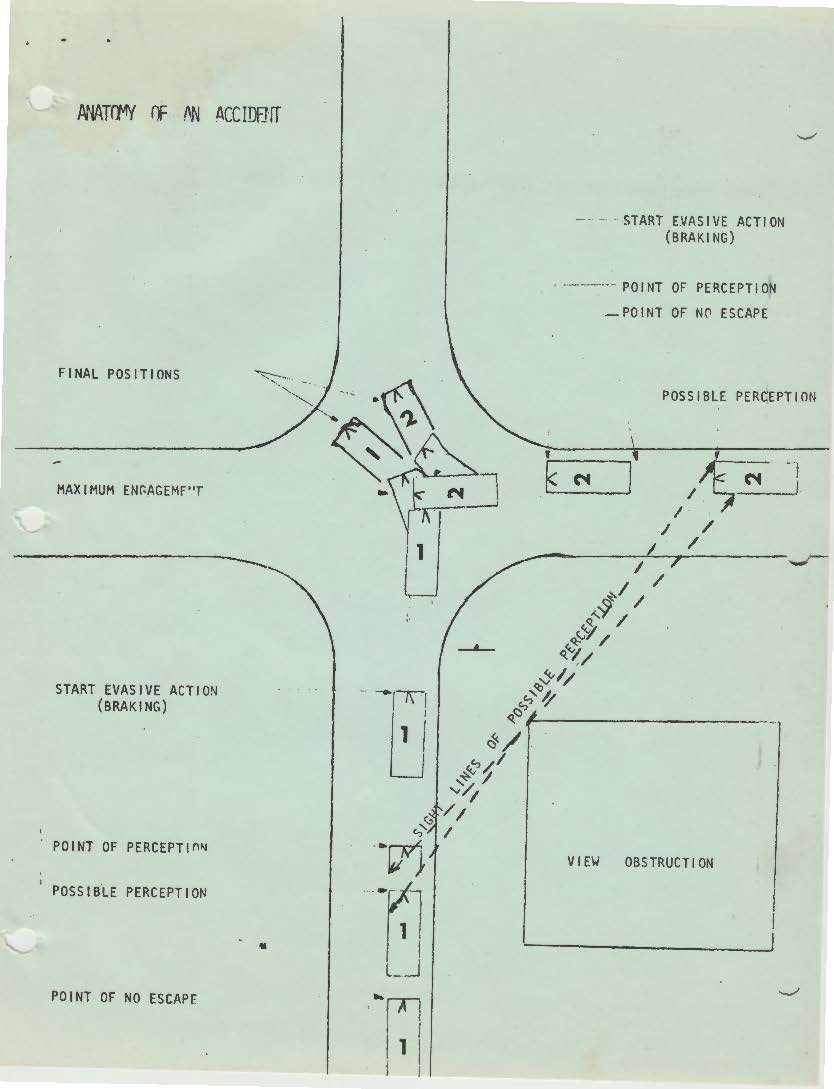HALL - CARPENTER, CO.
By Edwin T. Scallon, Copyright © 1990, 1995, 2008 All Rights Reserved
ACCIDENT RECONSTRUCTION AND BAC CALCULATION PROGRAMS
ANATOMY OF A COLLISION
There are distinct and separate points along the travel of a motor vehicle which either leads to a collision or the prevention of such a collision. The following are the points along that time line of events. If the events occur almost simultaneously where the point of possible perception overlaps the point of no escape, the collision is completely unavoidable and no matter what the operator does to avoid the collision it will occur.
A collision or motor vehicle accident is brought about by a sequences of events - a sequence of unexpected and unctolled events that leads to damage and/or injury. The basic categories of events are listed below:
1. Pooint of Possible perception (of hazard)
2. Point of actual perception (of hazard)
3. Point of no escape
4. Key event / Key point
5. Point of initial engagement
6. Pooint of mximum engagement
7. Point of disengagement
8. Final position or Final resting place
1. POINT OF POSSIBLE PERCEPTION: This is the time and place at which the hazardous situation could have been perceived by a normal person. This point always precedes the point of actual perception. Perception time is the time between point of possible perception and the point of actual perception. Maximum delay of perception is achieved when an operator does not perceive a hazard util physical contact is made.

2. POINT OF ACTUAL PERCEPTION OF HAZARD: This is the point at which an individual see, feels, hears or otherwise perceives an indication that an accident is about to occur (e.g., seeing an opposing vehicle cross the barrier line, hearing a horn on you left as you are about to change lanes, feeling the right wheels drop from the road to the soft shoulder, or feeling the start of a skid). The points of possible and actual perception are analyzed to determine the contribution of drivers and pedestrians to accidents. The time between the two points is of particular interest. The point of actual perception identifies the point at which evasive action should be taken.
3. POINT OF NO ESCAPE: This refers to the place and time after which a given individual cannot avoid or prevent an impending accident. Occasionally, the point of perception and point of no escape are one and the same. In other cases, the point of no escape precedes the point of perception. Frequently, the point of no escape follow the point of perception, indicating faulty judgment and /or skill in the execution of evasive action.
4. KEY EVENT OR KEY POINT: This is teh event which determines the time, place and type of accident that willoccur. It is whichever of the following classes of events that occurs firrst;
a. Non-collision on the roadway
b. Collision on the roadway
5. POINT OF INITIAL ENGAGEMENT: This is the point where contact is first made during a collision. Before this point, no mutual force is exerted between the objects. After this point, force begins to develop.
6. POINT OF MAXIMUM ENGAGEMENT: This is where the greatest collapse of material or overlap of objects occurs. The greatest force is exerted between objects as this point. This always follows the key event.and immediately follows the intitial engagement.
7. PINT OF DISENGAGEMENT: This refers to the point at which the objects or vehicles involved in the collision start to separate from one another and the initial force exerted between them ceases. Complete disengagement does not occur in all accidents.
8. FINAL POSITION: This is the time and place that the objects which have collided come to rest, without use of power. This position may be difficult to determine if the vehicle leave the scene, or roll down an incline after engagement. Vehicles may still be engaged at the final position. Often the final position of passengers or cargo may be quite different from the vehicle in question. The final positions of vehicles and related objects are quite useful in reconstruction of the accident. Vehicles do not have a "final position" if power is applied to move them. Drivers often move their vehicles to a safer position after a collision.
